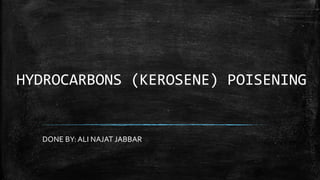
HYDROCARBONS (KEROSENE) POISENING
- 1. HYDROCARBONS (KEROSENE) POISENING DONE BY: ALI NAJAT JABBAR
- 2. INTRODUCTION ▪ Hydrocarbons are a diverse group of organic compounds consisting primarily of carbon and hydrogen atoms. ▪ Products containing hydrocarbons are found in many household and workplace settings and include fuels, lighter fluids, paint removers, pesticides, polishers, degreasers, and lubricants. ▪ Some volatile substances may be recreationally abused. Exposure may cause mild to severe toxicity and, rarely, sudden death.
- 3. CLINICAL FEATURES ▪ Chemical pneumonitis is the most common pulmonary complication and is most likely to occur following aspiration of a hydrocarbon with low viscosity (ability to resist flow), high volatility (tendency for a liquid to become a gas), and low surface tension (cohesive force between molecules). ▪ Symptoms occur quickly and include cough, gagging, choking, and dyspnea. Physical examination may reveal tachypnea, wheezing, grunting, and an elevated temperature. ▪ Radiographic abnormalities do not always occur. If radiographic findings occur, they may lag behind the clinical picture by 4 to 24 hours, but most are apparent within 6 hours.
- 4. CLINICAL FEATURES ▪ Cardiac toxicity manifests as potentially lethal dysrhythmias resulting from myocardial sensitization to circulating catecholamines (“sudden sniffing death syndrome”). Halogenated hydrocarbon solvents are most frequently implicated, but all classes of hydrocarbons have been associated with dysrhythmias. ▪ Central nervous system toxicity may present as intoxication, ranging from initial giddiness, agitation, and hallucinations to seizures, slurred speech, ataxia, and coma. Chronic exposure may cause recurrent headaches, cerebellar ataxia, and mood lability.
- 5. CLINICAL FEATURES ▪ Gastrointestinal toxicity can include vomiting (which can lead to aspiration), abdominal pain, anorexia, and hepatic damage (particularly from halogenated hydrocarbons such as carbon tetrachloride, methylene chloride, trichloroethylene, and tetrachloroethylene). ▪ Dermal toxicity includes contact dermatitis and blistering with progression to full-thickness burns. Injection of hydrocarbons can cause tissue necrosis. Burns can result after cutaneous contact with hot tar and asphalt. ▪ Less common acute toxicities include hematologic disorders such as hemolysis, methemoglobinemia, carboxyhemoglobinemia (from methylene chloride), and renal dysfunction.
- 6. DIAGNOSIS ▪ Determine the specific hydrocarbon-containing product, because identification can help anticipate specific potential toxicity and guide management. ▪ Pulse oximetry is useful to evaluate oxygenation status. ▪ Arterial blood gas analysis can be used to assess ventilation and acid- base status. ▪ Cardiac rhythm monitoring and an ECG are indicated in symptomatic patients and patients who ingest halogenated hydrocarbons.
- 7. ▪ Chest radiographs may be normal for as long as 8-12 hr after aspiration, but more often will be positive after 6 hr or longer from the time of exposure. whenever possible, chest radiograph should be delayed until 6 hr or longer after the hydrocarbon exposure. ▪ Chest radiographs may remain abnormal long after the patient is clinically normal, and they should not be used to guide acute treatment. ▪ Pneumatoceles may appear on the chest radiograph 2-3 wk after exposure.
- 8. DIAGNOSIS ▪ There are no specific quantitative hydrocarbon tests in standard use when evaluating suspected hydrocarbon intoxication. ▪ A basic metabolic panel is indicated in patients with a history of toluene abuse or in whom electrolyte abnormalities and renal insufficiency are suspected. ▪ Obtain hepatic function studies, serum ammonia, and prothrombin time in patients who ingest or inhale halogenated hydrocarbons. ▪ A CBC is indicated if anemia, bleeding disorder, hemolysis, or leukemia is considered. ▪ Measure carboxyhemoglobin level in patients with exposure to methylene chloride; repeat measurements may be necessary.
- 9. DIAGNOSIS ▪ Determination of methemoglobin level is indicated in patients with exposure to hydrocarbons containing amine functional groups. ▪ Abdominal radiographs may show evidence of ingestion of chlorinated hydrocarbons such as carbon tetrachloride or chloroform because of the radiopaque nature of polyhalogenated substances.22 ▪ An outpatient nerve conduction study and electromyography can be considered in patients who present with chronic numbness and paresthesias in the extremities and who have a history of n-hexane exposure.
- 10. Severity score
- 11. EMERGENCY DEPARTMENT CARE AND DISPOSITION ▪ 1. Secure the airway and maintain ventilation support in patients with respiratory insufficiency or neurologic depression. Administer oxygen to symptomatic patients and place them on a cardiac monitor (seeTable 111- 2). An EKG should be obtained. ▪ 2.Treat hypotension with intravenous crystalloid infusion. Avoid catecholamines except in cases of cardiac arrest.Treat tachydysrhythmias with propranolol, esmolol, or lidocaine. Avoid class IA and III agents. ▪ 3. Follow standard hazardous material measures for decontamination of the patient. Initial decontamination should ideally be done at the scene and should include removal of the patient from the exposure (including clothing or dermal contact). Skin may be irrigated with soap and water. Activated charcoal is not indicated following isolated hydrocarbon ingestions.The use of gastric emptying is not beneficial, and this decontamination technique is not regularly employed following ingestion.
- 12. EMERGENCY DEPARTMENT CARE AND DISPOSITION ▪ 4. Meticulous wound care with potential surgical debridement is indicated for dermal exposures.Treat tar and asphalt injuries with immediate cooling and cold water, and application of ointment combined with surface-active agents (e.g., Polysorbate 80). ▪ 5. Prophylactic antibiotics are not generally indicated. Corticosteroid use is not indicated. ▪ 6. Admit symptomatic patients, those exposed to hydrocarbons capable of producing delayed toxicity (e.g., halogenated hydrocarbons), and those exposed to hydrocarbons with toxic additives (e.g., pesticides or organic metal compounds). Patients with severe respiratory distress may need
- 14. DISCHARGE ▪ For pediatric hydrocarbon ingestions, the presence of wheezing, altered consciousness, or tachypnea within 2 hours predicts the need for further treatment. ▪ Children with history of exposure are safe to discharge if they have: 1. no symptoms. 2. very transient coughing or gagging. 3. normal physical exam after 4 hours. 4. normal CXR after 6 hours.